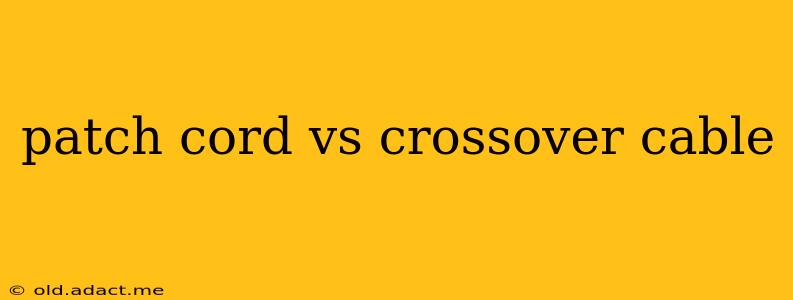Choosing the right cable for your network can seem confusing, especially when faced with terms like "patch cord" and "crossover cable." While both are used to connect network devices, they serve different purposes and have distinct wiring configurations. This comprehensive guide will clarify the differences, helping you select the appropriate cable for your networking needs.
What is a Patch Cord?
A patch cord, also known as a patch cable, is a relatively short cable used to connect network devices of the same type. This typically means connecting a computer to a switch, a switch to a router, or a router to a modem. The most common type uses the straight-through wiring scheme, meaning that pins 1 and 8 on one end connect to pins 1 and 8 on the other end, respectively, and so on for all eight pins. This simple setup allows for seamless communication between devices that operate on the same network standard, utilizing the same data transmission method.
What is a Crossover Cable?
A crossover cable is designed to connect two devices of the same type that would normally communicate through a hub or switch. The key difference lies in its wiring scheme. Unlike a patch cord, a crossover cable reverses the transmit (TX) and receive (RX) pairs. This means the transmit pins on one end are connected to the receive pins on the other end, and vice-versa. This clever wiring is crucial for direct communication between two devices without an intermediary networking device, facilitating direct connection between devices such as two computers or two network switches.
Why the Difference in Wiring?
The difference in wiring stems from how network devices communicate. Most network devices (like computers and switches) use a "half-duplex" system where they send and receive data on the same wires. A straight-through cable is needed to avoid conflicting signals that may otherwise result in dropped or corrupted data. However, when connecting devices directly without a central hub or switch, the crossover cable ensures each device transmits on its own wire, preventing this signal conflict and successful data exchange.
What happens if you use the wrong cable?
Using the incorrect cable type can lead to communication failures. A crossover cable used to connect a computer to a switch will likely result in a connection failure. Similarly, a patch cord used to directly connect two computers will generally not work, though some modern devices auto-negotiate so that connections might be successful despite this mismatch. Auto-negotiation detects what type of cable is plugged in and adjusts accordingly, but this is not guaranteed, and it is best practice to use the correct cabling for your situation.
Patch Cord vs. Crossover Cable: A Summary Table
| Feature | Patch Cord | Crossover Cable |
|---|---|---|
| Wiring | Straight-through | Transmit/Receive pairs reversed |
| Use Case | Connecting similar devices (computer to switch, switch to router) | Connecting similar devices directly (computer to computer, switch to switch) |
| Intermediary | Requires a hub or switch | No hub or switch required |
| Modern Usage | Much more common | Less common due to auto-negotiation |
Are Crossover Cables Still Necessary?
With the prevalence of auto-negotiating network interfaces (NICs) in modern devices, the need for crossover cables has significantly diminished. Most modern devices can automatically detect the cable type and adjust accordingly. However, understanding the difference between patch cords and crossover cables is still beneficial for troubleshooting network issues and ensuring optimal connectivity. For older or less sophisticated equipment, however, it is important to know which type of cable to use for a proper connection.
How to Identify a Patch Cord and Crossover Cable?
While some cables may be clearly labeled, many aren't. The best way to be sure is to test the cable with a cable tester, or if possible to check the wiring scheme at the plugs with a multimeter or continuity tester.
In conclusion, while the distinction between patch cords and crossover cables remains important, understanding their functionalities and the implications of using the wrong cable type is crucial for effective network management and troubleshooting. With this knowledge, you can confidently select the appropriate cable for your needs and maintain a stable, high-performing network.
